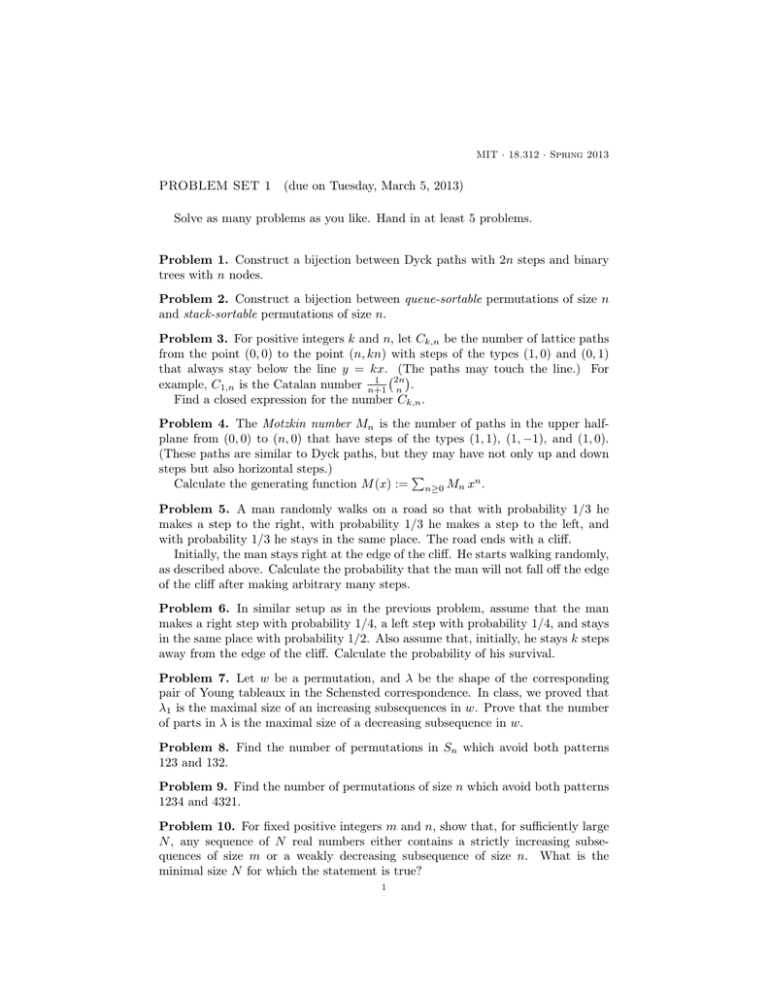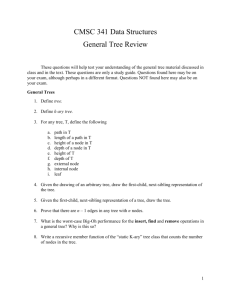(due on Tuesday, March 5, 2013) PROBLEM SET 1
advertisement

MIT · 18.312 · Spring 2013
PROBLEM SET 1
(due on Tuesday, March 5, 2013)
Solve as many problems as you like. Hand in at least 5 problems.
Problem 1. Construct a bijection between Dyck paths with 2n steps and binary
trees with n nodes.
Problem 2. Construct a bijection between queue-sortable permutations of size n
and stack-sortable permutations of size n.
Problem 3. For positive integers k and n, let Ck,n be the number of lattice paths
from the point (0, 0) to the point (n, kn) with steps of the types (1, 0) and (0, 1)
that always stay below the line y = kx. (The
paths may touch the line.) For
2n
1
.
example, C1,n is the Catalan number n+1
n
Find a closed expression for the number Ck,n .
Problem 4. The Motzkin number Mn is the number of paths in the upper halfplane from (0, 0) to (n, 0) that have steps of the types (1, 1), (1, −1), and (1, 0).
(These paths are similar to Dyck paths, but they may have not only up and down
steps but also horizontal steps.)
P
Calculate the generating function M (x) := n≥0 Mn xn .
Problem 5. A man randomly walks on a road so that with probability 1/3 he
makes a step to the right, with probability 1/3 he makes a step to the left, and
with probability 1/3 he stays in the same place. The road ends with a cliff.
Initially, the man stays right at the edge of the cliff. He starts walking randomly,
as described above. Calculate the probability that the man will not fall off the edge
of the cliff after making arbitrary many steps.
Problem 6. In similar setup as in the previous problem, assume that the man
makes a right step with probability 1/4, a left step with probability 1/4, and stays
in the same place with probability 1/2. Also assume that, initially, he stays k steps
away from the edge of the cliff. Calculate the probability of his survival.
Problem 7. Let w be a permutation, and λ be the shape of the corresponding
pair of Young tableaux in the Schensted correspondence. In class, we proved that
λ1 is the maximal size of an increasing subsequences in w. Prove that the number
of parts in λ is the maximal size of a decreasing subsequence in w.
Problem 8. Find the number of permutations in Sn which avoid both patterns
123 and 132.
Problem 9. Find the number of permutations of size n which avoid both patterns
1234 and 4321.
Problem 10. For fixed positive integers m and n, show that, for sufficiently large
N , any sequence of N real numbers either contains a strictly increasing subsequences of size m or a weakly decreasing subsequence of size n. What is the
minimal size N for which the statement is true?
1
2
Problem 11. An increasing labelling of a rooted tree T is a way to label the nodes
of T by the numbers 1, 2, . . . , n such that each number appears exactly once, and
the labels increase as we move along the edges of T away from the root.
Prove the “baby hooklength formula” for the number increasing labellings of a
rooted tree T .
Problem 12. Prove the hooklength formula for the number of shifted standard
Young tableaux. Can you modify the probabilistic “hook walk” method for this
case?
Problem 13. An increasing tree is a tree on the nodes labelled 1, 2, . . . , n such
that the labelling is increasing (assuming that the vertex “1” is the root). Find the
number of increasing trees on n nodes.
Problem 14. An increasing binary tree is a binary tree together with an increasing
labelling of its nodes. Prove that the number of increasing binary trees with n
nodes and k left edges equals the number of permutations in Sn with k descents
(the Eulerian number).
Problem 15. An semi-increasing binary tree is a plane binary tree together with
a labelling of its nodes by the numbers 1, 2, . . . , n (each label appears once), such
that the label of a parent node is less than the label of its left child.
Find the number of semi-increasing binary trees with n nodes.
Problem 16. For positive integers n, n1 , . . . , nk such
that n = n1 + · · · + nk , prove
n
[n]q !
is a polynothat the q-multinomial coefficient
:=
[n1 ]q ! · · · [nk ]q !
n1 , n2 , . . . , nk q
mial in q with positive integer coefficients. What is the degree of this polynomial?
Problem 17. Find the number of m × n matrices of rank 1 over a finite field Fq .
Problem 18. Let [n]
denote the set of all i-element subsets in {1, . . . , n}. For
i
positive integers n and i such that i < n/2, construct an injective map f from [n]
i
[n]
such that f (I) ⊃ I for any I ∈ [n]
to i+1
i .
Problem 19. Let X and D be the operators that act on polynomials f (x) as follows
X : f (x) 7→ xf (x). D : f (x) 7→ f 0 (x) and Define the sequence of polynomials fn (x)
by fn (x) := (X + D)n · 1. For example, f1 = 1, f2 = x, f3 = x2 + 1, f4 = x3 + 3x,
etc. Calculate the constant term fn (0) of the polynomial fn (x).
Problem 20. Show that the number of inversions inv (w) and the major index
maj (w) are equidistributed statistics on permutations w in Sn .






